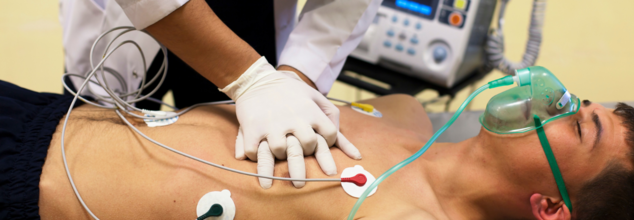- Health Conditions A-Z
- Health & Wellness
- Nutrition
- Fitness
- Health News
- Ayurveda
- Videos
- Medicine A-Z
- Parenting
- Web Stories

Credits: Canva
Ignored, Misdiagnosed And At Risk: Why Women Need To Listen To Their Heart?
Even after decades of health education campaigns and medical breakthroughs, there is still one myth that dangerously persistent—the heart disease is a "man's disease." This misconception has contributed to a fatal blind spot in diagnosing, treating, and managing women across the globe. The reality is even more sinister: cardiovascular disease (CVD) is the world's biggest killer of women, killing more people annually than all cancers together.
What's even more troubling is that the problem continues to exist in the face of decades of data, research, and advocacy by groups such as the American Heart Association (AHA), who continue to raise the alarm. Women are being misdiagnosed, underdiagnosed, and undertreated—particularly young women and women of color—resulting in avoidable deaths and long-term health repercussions.
Young Women Are Facing More of Heart Disease
Once thought to be at risk only after menopause, young women are increasingly having heart attacks and other cardiovascular events. Increasingly, studies now indicate that heart disease is increasing among young women between the ages of 18 to 55, a trend that has puzzled experts and rendered emergency rooms unprepared to recognize early warning signs among this group.
These women aren't only falling ill to the disease—they're also more prone to be sicker and to fare worse than age-matched men. They face this with further delayed diagnoses, with research indicating that women wait an average of more than two days before describing heart attack symptoms, compared with 15 hours for men.
Some of the challenge is the way heart attacks manifest in women. Men usually see the hallmark symptom of crushing chest pain, but women tend to present with more insidious, unusual symptoms, such as:
- Shortness of breath
- Jaw, back, or neck pain
- Nausea or vomiting
- Indigestion
- A feeling of dread
- Unusual fatigue or palpitations
These symptoms are commonly misinterpreted—by both physicians and patients—into stress, anxiety, or gastrointestinal distress, resulting in delays in treatment. Indeed, women are less likely to be immediately provided an electrocardiogram (EKG) in the ER and frequently are released from the ER without proper diagnostics or treatment.
Why Women Are Misdiagnosed?
Apart from symptoms, the body physiology of a woman's heart is not the same as a man's, making things even more complicated. Women have smaller vessels, are more prone to microvascular disease, and have special types of heart attacks like spontaneous coronary artery dissection (SCAD) and myocardial infarction with nonobstructive coronary arteries (MINOCA). These are the kinds that don't register on standard tests, so women's heart attacks might be completely overlooked.
More disturbing is the inherent gender bias in healthcare. Studies indicate women and minorities spend more time in the ER waiting for treatment, are less likely to be hospitalized, and do not get prescribed life-saving medications following a heart attack. The AHA says 26% of women die within one year of experiencing their first heart attack, as opposed to 19% of men.
Pioneering cardiologists are dubbing it a global health crisis. A groundbreaking consensus statement by 33 specialists from the British Cardiovascular Society has provided a vision plan for closing these disparities. The statement is urging:
- Champions and specialist centers for women's heart health
- Equal diagnostics and treatments
- More women in clinical trials
- Care models that are culturally and gender-sensitive
It also draws attention to the fact that more than 3.6 million women in the UK alone suffer from ischemic heart disease, with most getting delayed or suboptimal treatment. This is replicated all over the world—from the US to South Asia—due to old-fashioned medical beliefs, societal prejudices, and ignorance.
What Women Can Do Right Now?
For far too long, women's voices—particularly when they are reporting pain or discomfort—have been ignored or trivialized. But your body remembers when something's amiss, and listening to your heart may save your life.
Here's what you can do:
Learn your risk factors—blood pressure, cholesterol, diabetes, and family history.
Speak up for yourself—question your doctor, ask for proper tests, and don't be afraid to seek a second opinion.
Pay attention to the signs—even if they don't fit the norm.
Live a heart-healthy life—eat healthfully, stay active, cope with stress, and have regular check-ups.
Women such as Stewart, a heart attack survivor and advocate for the AHA's Go Red for Women initiative, remind us that awareness alone is not sufficient. Education, action, and advocacy are needed to turn back the deadly tide of overlooked and undiagnosed heart disease in women.
Heart disease does not discriminate, yet the medical system still does. From delay in ER treatment to exclusion from clinical trials, women are perpetually an afterthought in the world of cardiovascular medicine. That has to end. Whether you are a 20-year-old woman, a mother managing stress, or a retired grandmother, your heart matters. And so does it deserve equal attention, equal care, and a more louder voice.

(Credit-Canva)
Research Reveals The Surprising Number Of Lifestyle Choices That Put Our Heart Health At Risk
Living a healthy lifestyle is crucial for your heart health. We all have heard this from our doctors, peers, as well as multiple studies across the internet. The number of things that could have a negative impact on your heart keeps seemingly increasing, leaving many of us wondering how many more things we should be aware of. New research has painted a clear picture for us and gives the exact number of everyday risks that could slash the risk of heart attack by 63%. In the study published in the Canadian Journal of Cardiology, researchers were surprised to find that removing 56 unfavorable profiles, could lower the chances of declining heart health.
This shows that what we do every day has a really big impact on our heart health and our chances of this happening.
The researchers compared the people who had a sudden cardiac arrest with those who stayed healthy. They looked at 125 different things that people can change, like what they eat, how much they exercise, if they smoke or drink, how they feel emotionally, and even things like their job and money situation. The place you live at can also be a factor as the study noted that things like air pollution, traffic proximity and intensity, the percentage of natural environment can also affect your heart health. This helped them figure out which of these things were most strongly linked to having a sudden cardiac arrest.
Preventable Variables To Look Out For
The study found 56 things in our daily lives, our surroundings, and our health that can lead to sudden cardiac arrest. If we pay attention to these things and make them better, like eating healthier or being more active, we might be able to stop up to 63% of these heart problems from happening. It's about looking at all the pieces of our lives.
The researchers expressed their astonishment over how many cases we could possibly prevent. He said that if people who have unhealthy habits or situations made improvements, we could see a big drop, somewhere between 40% and 63%, in the number of sudden cardiac arrests. This shows that making positive changes can have a much bigger effect than we might think.
How Did The Researchers Find This?
To learn more about what causes these heart problems, the researchers looked at a lot of information from a long-term health study in the UK. This study followed over 500,000 people for many years. During that time, more than 3,000 of them had a sudden cardiac arrest. By looking at all this data, the researchers could start to see patterns and find the things that might be increasing the risk.
The research draws attention towards the increasing numbers of people suffering with heart diseases in the world. According to the American Heart Association in just one year 436,000 American died due to cardiac arrests. Cardiovascular diseases are the leading cause of death globally, taking 17.9 million lives each year. Hence, changing a few necessary things to protect your heart could save your life in the long run.

(Credit-Canva)
Undiagnosed Depression In Fathers Affects Children's Mental Health
Fathers are always portrayed as the strong ones who keep the family together. Many are not given the space to express their emotions in a healthy way. The idea that dads need to be strong and stoic affects many men in different ways. The surprising state of men’s mental health is evident in different statistics. According to World Health Organization (WHO), men commit suicide twice the rate more than women. About 80% of suicides reported in the US happen to be men. The Centers for Disease Control and Prevention (CDC) explains that men are four times more likely to die by suicide.
Not only is the lack of mental health care affecting men all around the world, but new study shows, their depression may have an effect on their children’s well-being. In a recent report done by the American Journal of Preventive Medicine, researchers found that children, whose fathers have undiagnosed depression, are more likely to have behavioral issues.
What Kinds Of Behaviors Did These Kids Exhibit?
The study found that young kids whose dads were found to be depressed, undiagnosed, were more likely to be restless and act out as they got older. By the time they were nine, they showed more anger and defiance. They also had a harder time working with others and didn't feel as good about themselves. This suggests that a father's early mental health can shape a child's behavior for many years.
Experts point out that we usually focus on mothers' mental health, especially after having a baby. However, this study reminds us of that fathers' mental health is just as important. We need to think about both parents' well-being because they both play a big role in raising their children. Ignoring one parent's struggles isn't good for the family as a whole.
How Common Is Parental Depression?
It might surprise you to learn that many fathers go through periods of feeling depressed when their kids are young. In fact, around 8 to 13 out of every 100 fathers in the US experience this. If the mother is also struggling with depression after giving birth, the chances of the father feeling depressed can shoot up, affecting as many as half of them.
To understand how fathers' mental health affects kids, researchers looked at information from a long-term study. They followed over 1,400 children born in big cities across the US. When the kids were five, they asked the fathers about any signs of depression. Then, when the kids were nine, their teachers helped assess how they were behaving in school and with others. This helped the researchers see connections over time.
Parent’s Mental Health Affect The Child’s Behavior
The results of the study clearly showed that there was a connection between fathers who were depressed and children who had more behavioral problems. The researchers found a pattern suggesting that when fathers struggle with their mental health, it can have a direct impact on how their children act and feel as they grow older.
When a father is depressed, it can make it harder for him to be the kind of parent he wants to be. For example, he might find it difficult to give his children the emotional support they need, like listening to their problems or offering comfort. His own sadness can also create tension and arguments at home, making the environment stressful for everyone in the family, including the kids.
When parents show their children that it's okay to ask for help when they're struggling, it teaches a valuable lesson. It shows kids that everyone faces challenges and that reaching out is a sign of strength, not weakness. This understanding can stay with children throughout their lives, making them more likely to seek support when they need it too.

Credits: Canva
5 Common Gynaecological Conditions You Should Know About
Women’s reproductive health is a vital part of overall well-being, but it often doesn’t get the attention it deserves. Conversations around it are still considered taboo in many communities. Because of this silence, many women continue to suffer through discomfort, pain, and long-term health issues without proper help. Some of these problems, if ignored, can affect fertility or even become life-threatening.
Here’s a look at five common gynaecological issues that affect women and why it's important to address them early.
Menstrual Problems
Many women experience some discomfort during their periods, but when the pain is severe, it could be a sign of dysmenorrhea. This condition causes intense cramping in the lower abdomen or back, often disrupting daily life. It happens due to strong uterine contractions that reduce blood flow and oxygen to the tissues.
Another issue is menorrhagia, or unusually heavy periods. This can lead to fatigue and anaemia if not managed. Then there are irregular periods, which may signal hormonal imbalances or conditions like Polycystic Ovary Syndrome (PCOS).
Ignoring menstrual irregularities may lead to bigger health problems later, including fertility issues.
Vaginal Infections and Discomfort
Many women experience vaginal infections at some point. These can result from bacterial, fungal, or yeast overgrowth. A condition called vaginitis often presents with itching, burning, unusual discharge, or changes in odour.
Although treatable, recurring infections should not be ignored, as they may point to an underlying health concern. Regular hygiene and medical attention can help prevent complications.
Ovarian Cysts and PCOS
Ovarian cysts are fluid-filled sacs that can develop on the ovaries. While most are harmless and go away on their own, some can cause pain or discomfort and may need medical attention.
Polycystic Ovary Syndrome (PCOS) is a more serious condition that causes multiple small cysts on the ovaries. It’s linked with hormonal imbalances that can lead to irregular periods, acne, hair growth, weight gain, mood changes, and difficulties in getting pregnant. Managing PCOS often involves lifestyle changes and medication.
Endometriosis and Fibroids
Endometriosis occurs when tissue similar to the uterine lining grows outside the uterus. It can cause painful periods, heavy bleeding, pain during sex, digestive problems, and infertility. Treatment may include hormone therapy, pain relief, or surgery, depending on severity.
Fibroids are non-cancerous growths inside or around the uterus. They may cause heavy periods, pelvic pressure, or frequent urination. While some fibroids don’t need treatment, others may require medication or surgical removal.
Urinary Tract Issues
Urinary Tract Infections (UTIs) are common in women and can cause a burning sensation during urination, lower abdominal pain, and the need to urinate frequently. Prompt treatment with antibiotics is usually effective.
Urinary incontinence, or the loss of bladder control, may happen after childbirth or during menopause. It’s often treatable with pelvic floor exercises, medication, or surgery.
Why It Matters
Bringing these issues into open conversation helps women take charge of their health. Early detection and treatment can make a big difference—preventing long-term complications and improving quality of life.
© 2024 Bennett, Coleman & Company Limited

